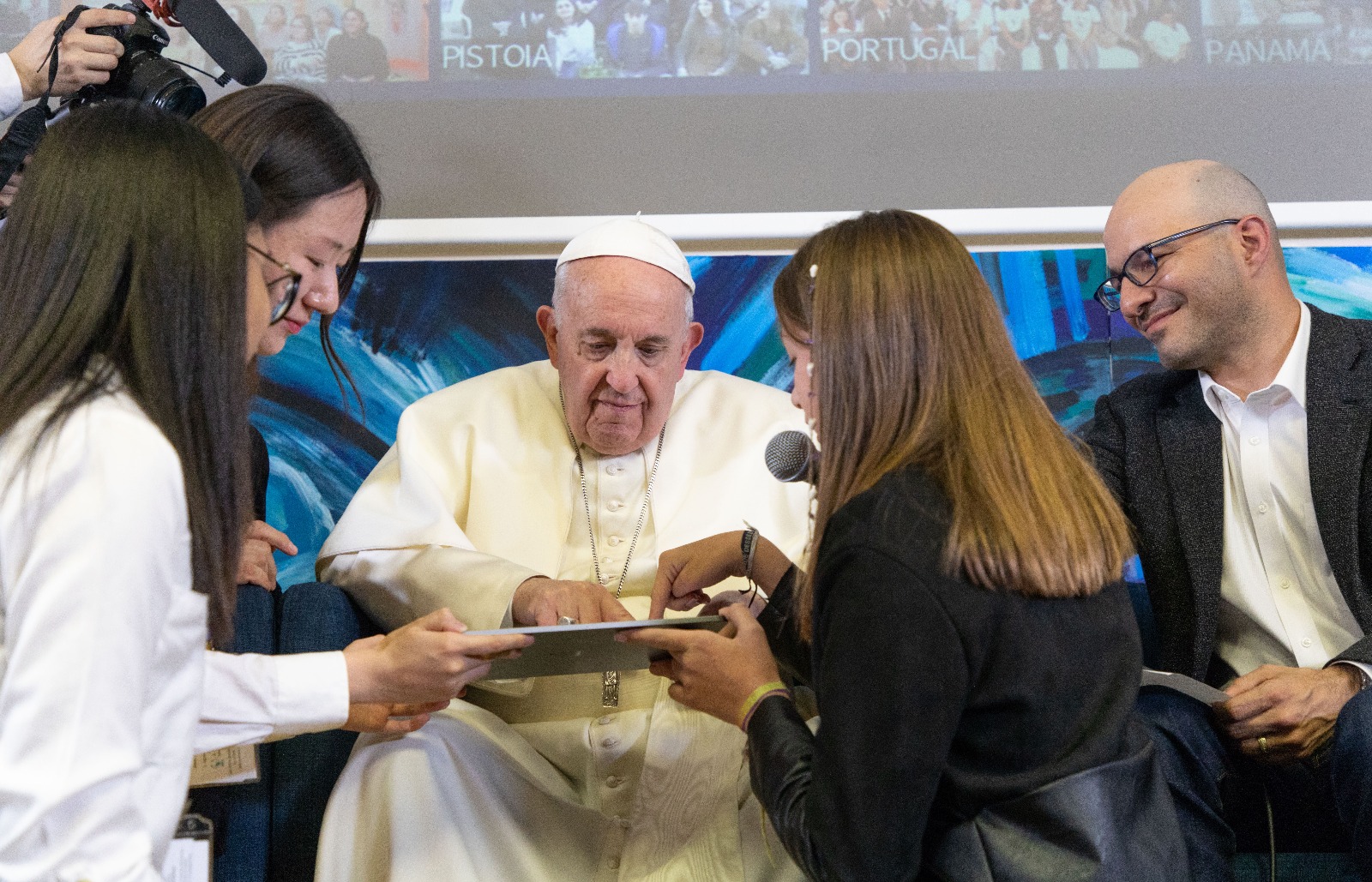Tech
Pope Francis Encourages More Children To Code, Especially In Catholic Countries

Pope Francis has backed a global effort launched by a Polish tech entrepreneur to encourage more children to learn computer programming.
Miron Mironiuk, the founder of the artificial intelligence business Cosmose AI, is drawing on his own life-changing experience with coding.
He stated that the “Code with Pope” program would help bridge “the glaring disparities in education” worldwide.
It is envisaged that the Pope’s participation will attract Catholic countries.
“We believe that the involvement of the Pope will help to convince them to spend some time and use this opportunity to learn programming for free,” Mironiuk said in an interview with the BBC.
The effort will promote access to coding instruction for pupils aged 11 to 15 across Europe, Africa, and Latin America by providing a free online learning environment.
Children will be prepared with the fundamentals of Python, one of the world’s most popular coding languages, after 60 hours of concentrated learning.
Programming abilities have become as important as reading and writing in the digital age.
According to World Economic Forum data issued in 2023, “the majority of the fastest growing roles are technology-related roles.”
 On the other hand, a serious global scarcity of digital skills threatens to leave 85 million job openings unfilled by 2030.
On the other hand, a serious global scarcity of digital skills threatens to leave 85 million job openings unfilled by 2030.
As a result, expanding access to high-quality programming education has become critical, especially in low and middle-income nations, many of which are Catholic.
A sizable proportion of the Polish population is Catholic.
Mr Mironiuk, 33, told the BBC that he was proud of his Polish heritage and to be part of a generation of accomplished people working in technology.
Poland is making tremendous achievements in the IT scene, notably in AI, with companies such as Google Brain, Cosmose AI, and Open AI employing many Poles.
However, Mr Mironiuk is aware that many countries are less fortunate, and he hopes that this educational campaign will help to change that.
The program will be offered in the following languages: Spanish, English, Italian, and Polish. It is expected to reach children throughout South America, except Brazil, and in English-speaking countries in Africa and South East Asia.
This is not the Pope’s first time encouraging young people to learn to code; in 2019, he helped write a line of code for a UN program.
Mr. Mironiuk will meet with Pope Francis at the Vatican. He confesses, however, that he does not expect the Pope to replicate his students in learning new talents.
“I don’t expect him to know Python very well, at least,” he told me. “But he will get a certificate for his efforts in helping start the programme.”
SOURCE – (BBC)
Tech
On December 24, NASA’s Parker Solar Probe Will Make Its Closest Approach To The Sun.

(VOR News) – NASA’s Parker Solar Probe will make its last approach to the sun, according to the National Aeronautics and Space Administration (NASA).
This is expected to take place on the 24th of December. On this particular date, it is widely predicted that the project will be finished on time.
It has been reported by Sci Tech Daily that the Parker Solar Probe, which is currently in fine condition and is being controlled by the National Aeronautics and Space Administration (NASA), is functioning in an efficient manner. This data was provided by the National Aeronautics and Space Administration.
The National Aeronautics and Space Administration (NASA) is in charge of supervising the Living With a Star Program, which includes the Parker Solar Probe, which is an essential undertaking associated to the program.
The program is managed by NASA.
The program’s principal mission is to conduct research to enhance understanding of the Sun and its effects on Earth.
The airplane is projected to traverse a distance of 3.8 million miles (6.1 million kilometers) from the Sun throughout the mission. In comparison to the Sun, this distance signifies an exceptionally close encounter with the star in question.
The persons responsible for the mission will encounter difficulties in contacting them during the interval when the spacecraft is at its closest approach, known as perihelion.
On December 27th, subsequent to the flyby, it will transmit a signal to confirm its proper functionality and acceptable operation. This will provide as evidence that it is functioning within its standard parameters. The implementation of this plan will ensure its proper functioning.
The acquisition of fresh knowledge and discoveries related to solar activity and phenomena will be facilitated by the subsequent collecting of these data.
“This exemplifies NASA’s audacious missions, undertaking unprecedented endeavors to address enduring inquiries regarding our universe,” stated Arik Posner, a scientist involved in the Parker Solar Probe program at NASA Headquarters in Washington.
“This exemplifies one of NASA’s audacious missions.” “This exemplifies one of NASA’s audacious missions.” “This exemplifies one of NASA’s audacious missions.”
“This has to be one of NASA’s most ambitious undertakings.”
Posner dedicated time and effort to composing this assertion, which he then included into a publicly released statement.
He remarked, “We anticipate receiving the initial status update from the spacecraft and commencing the acquisition of scientific data in the forthcoming weeks.”
This constitutes an additional point of interest. These are additional things of interest to contemplate. This subject is attracting significant attention from persons worldwide.
While at the Advanced Photon Technologies (APT) laboratory, Nick Pinkine, newly appointed mission operations manager for the Parker Solar Probe, noted that “no human-made object has ever approached a star this closely, thus Parker will indeed be transmitting data from uncharted territory.”
Pinkine is responsible for supervising the mission activities of the Parker Solar Probe and is accountable for these operations. Pinkine’s observation pertains to the Parker Solar Probe’s return of data from hitherto uncharted locations. These ecosystems have not been before encountered.
He issued the following remark for the sake of clarification: “We anticipate a response from the spacecraft upon its completion of the solar orbit.”
SOURCE: JN
SEE ALSO:
Google Responds To The US Bid To Mandate Chrome’s Sale.
Social Security Change Approved By Senate Despite Fiscal Concerns
Tech
Google Responds To The US Bid To Mandate Chrome’s Sale.

(VOR News) – Google responded to a request from the United States to sell its Chrome browser late on Friday. The request was made by Google’s Chrome browser.
A judge should be asked to settle antitrust issues by barring the corporation from making advantageous treatment of its software a condition of licensing, according to the company’s proposal.
According to a proposed judgement that Google has published, which is twelve pages long, it is forbidden for the internet giant to demand favourable distribution or treatment of its software on mobile devices as a condition of licensing popular apps like Chrome, Play, or Gemini. This is because the proposed ruling prohibits such a requirement.
The United States government, as part of a substantial antitrust assault on the firm, made a motion to a judge in November to compel the deconstruction by selling its Chrome browser, which is widely used. This phase of the inquiry into the corporation was part of a bigger antitrust investigation.
The US Justice Department has called for a shake-up of Google’s business.
This shake-up would include forbidding deals that would allow Google to be the default search engine on mobile devices and preventing the corporation from exploiting its Android mobile operating system among other things.
United States District Court Judge Amit Mehta concluded in August that Google was a monopoly. The next stage of the historic antitrust trial is to discover how to repair the wrongs that Google has committed in its business practices. This is the next stage of the trial.
Google has urged that Mehta stop it from using the licensing desirability of its programs to compel mobile device manufacturers to pre-install its search engine or make it the default option, according to a court filing.
Mehta has also requested that Google be prohibited from employing this method. This request was made in response to the proposition that Mehta had made.
The order that is being considered states that “nothing in this Final Judgement shall otherwise prohibit Google from providing consideration to a mobile device manufacturer or wireless carrier with respect to any product or service in exchange for such entity’s distribution, placement on any access point, promotion, or licensing of that Google product or service.” This clause is incorporated into the order that is being requested.
The decision made by the authorities of the United States government to call for the dissolution of Google reflects a fundamental departure in the approach that they have taken. The authorities have, for the most part, disregarded the digital titans ever since they were unsuccessful in their attempt to smash Microsoft twenty years ago.
If Judge Mehta denies the injunction, Google will likely appeal.
This will most certainly cause the process to drag on for a number of years, and it is possible that the Supreme Court of the United States will have the final word in the matter.
A further issue that has the potential to influence the outcome of the case is the fact that President-elect Donald Trump arrived at the White House in the month of January.
There is a significant possibility that his administration will replace the leadership team that is now in charge of the antitrust division of the Justice Department under the current government.
When it comes to the newcomers, they have three choices: they may either continue with the case, they can ask Google for a settlement, or they can choose not to pursue the case at all.
The trial, which was completed the year before, included an investigation into confidential deals with smartphone manufacturers, including Apple. This investigation was carried out for the entirety of the trial.
The objective of these collaborations is to ensure that Google’s search engine is the default option on any device, including browsers, iPhones, and other gadgets. This is accomplished by charging substantial fees.
The judge came to the judgement that this relationship provided Google with access to user data that was unmatched by any other corporation. As a result, Google was able to build its search engine into a platform that is at the forefront of competition on a worldwide scale.
SOURCE: BR
SEE ALSO:
Nukkleus Acquires Star 26 Capital Inc., Marking a Strategic Shift.
Facebook Owner Fined 251 Million Euros For a Data Leak In 2018.
Tech
Nukkleus Acquires Star 26 Capital Inc., Marking a Strategic Shift.

(VOR News) – A major strategic change has been made when Nukkleus Inc., a fintech business that specialises in digital financial technology, stated that it has paid $26 million to acquire a controlling 51% position in Star 26 Capital Inc.
Israel’s prestigious Iron Dome missile defence system is mostly supplied by RIMON, which Star 26 Capital owns a 95% controlling interest in.
With this acquisition, Nukkleus is expanding from its finance roots into the defence industry, interacting with a rapidly growing industry driven by shifting demands for global security. As businesses look into high-growth industries to improve their market position, the activity aligns with broader trends in strategic diversification.
The Role of Star 26 Capital in the World’s Defence Infrastructure
Through its full ownership in RIMON, Star 26 Capital Inc. plays a crucial role in Israel’s defence infrastructure. The Iron Dome missile defence system, a well acknowledged technology that has successfully saved civilian lives during rising regional tensions, depends heavily on RIMON.
The Iron Dome is renowned for its advanced radar and interceptor systems, which provide outstanding protection from artillery shells and short-range rockets.
Along with the Iron Dome, RIMON has made a name for itself as a key supplier of systems and components for other defence applications.
Their goods include masts, tactical vehicle solutions, specialist generators, and contemporary lighting systems—all crucial for security and military operations. The company operates through exclusive contracts and alliances, which increase its competitiveness in the market.
Nukkleus’s Strategic Justification
The purchase of Star 26 Capital by Nukkleus demonstrates a calculated diversification strategy. This move highlights the company’s goal to leverage emerging opportunities in defence technology, even though finance and digital assets are essential to its operations.
“The acquisition of Star 26 Capital represents a significant milestone, allowing us to enter the rapidly growing defence technology industry,” said Emil Assentato, CEO of Nukkleus. Because of its proven track record of providing vital defence solutions, RIMON is the best partner for us as we work to create long-term value for our investors.
Through this strategic move, Nukkleus is able to profit from the growing global defence budget, which has been exacerbated by regional conflicts, geopolitical instability, and increased security concerns.
By purchasing a share in Star 26 Capital, Nukkleus gains access to cutting-edge technologies and strengthens its position in a prominent international defence industry.
The process of diversification In Light of Changing Market Dynamics
Nukkleus has purposefully diversified its assets during the past year. In order to bolster its position in international financial markets, the company previously inked a term sheet to acquire Mercury Global, a cross-border payments provider.
By acquiring Star 26 Capital, Nukkleus is showcasing a well-rounded expansion strategy by leveraging both financial and defence technologies to increase its footprint.
Star 26 Capital will provide Nukkleus with a significant revenue stream outside of traditional fintech markets thanks to its involvement in the development of tactical vehicles, exclusive contracts for cutting-edge components, and vital contribution to defensive infrastructure.
The Future of Star 26 Capital and Nukkleus
Through the deal, Nukkleus’s financial expertise and Star 26 Capital’s technological know-how may work together more effectively.
Nukkleus is capable of researching financial innovations created especially for military supply chain management, defence contract procurement, and safe international payment options. In an increasingly digital environment, this integration may revolutionise the operational and transactional administration of defence companies.
According to industry analysts, Nukkleus made a bold and wise move by entering the defence market. With the growth of international defence markets and the increasing need for technologies like the Iron Dome, Nukkleus is well-positioned to benefit from this diversification strategy in the long run.
Final evaluation
The purchase of a majority stake in Star 26 Capital and, by extension, RIMON by Nukkleus Inc. represents a significant milestone in the company’s development.
Nukkleus has demonstrated its ability to identify and seize high-growth opportunities by moving from the financial sector to the defence technology sector. This deal strengthens Star 26 Capital’s position as a major player in the global defence ecosystem by providing new avenues for growth and innovation.
By strategically acquiring Star 26 Capital, Nukkleus demonstrated its proactive approach in the military technology space and opened the door for future expansion and influence in a number of industries.
SOURCE: AL
SEE ALSO:
TikTok’s Last Effort Requests Supreme Court Action About U.S. Prohibition.
Trudeau’s Government in Shambles as Ministers Resign
-
Politics4 weeks ago
Miller Expects 4.9 Million Foreigners to Leave Canada Voluntarily
-
News3 weeks ago
Nolinor Boeing 737 Crash Lands in Montreal
-
News3 weeks ago
“Shocking Video” Vancouver Police Shoot Armed Suspect 10 Times
-
Tech4 weeks ago
Increasing its Stake in OpenAI by $1.5 Billion is a Possibility for SoftBank.
-
Tech3 weeks ago
Canadian Media Firms Are Suing OpenAI in a Potential Billion-Dollar Dispute.
-
News4 weeks ago
Trudeau Called the Greatest Threat to NATO


 On the other hand, a serious global scarcity of digital skills threatens to leave 85 million job openings unfilled by 2030.
On the other hand, a serious global scarcity of digital skills threatens to leave 85 million job openings unfilled by 2030.
























